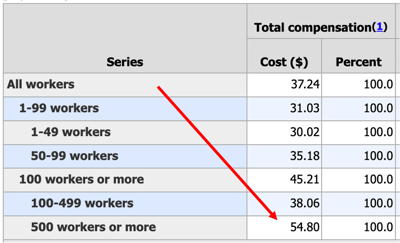![[Blog header] Compliance Program Economics 101: How to ask your boss for program funding.](https://www.thebroadcat.com/hubfs/Compliance-program-economics-101.png)
Compliance Program Economics 101: How to ask your boss for program funding.
Asking for money can be difficult or awkward.
We’ve already covered how to pitch requests to your boss in a big-picture way, but what do you do if things are a little more granular? Or when your specific ask isn't what last year's budget predictions envisioned?
First, make sure it’s actually worth the cost. Then, arm yourself with some economics-nerd knowledge to make your case. Read on, Team Broadcat, because we’ve got three economic concepts that help you get exactly what you need—and FREE email templates to get you started on those discussions with your boss.
Compliance Economics 101
Scenario: The Compliance Department (before your arrival, of course) purchased expensive and flashy (but useless) training
You: Hey Boss, I’d like to get more money for this training that would really improve our anti-bribery outcomes.
Boss: But we’ve already purchased this really expensive and flashy training that’s supposed to improve our anti-bribery outcomes.
You: THE SUNK COST FALLACY HAS TRICKED YOU!
🤓 A sunk cost refers to a cost that has already been incurred and can’t be reversed.
Here’s a real-life example:
I know someone who decided to watch Wandavision because it seemed like a fun spoof on old tv shows. So she started it, and halfway into the miniseries, learned that it is 100% NOT a parody show. In fact, it’s a superhero show, and she HATES anything superhero. But she kept watching it by rationalizing that because she already made it halfway through the series, she needs to finish it, or the time invested would have been a waste.

Same, Wanda. Same. | Source: WandaVision
That, Team Broadcat, is the sunk cost fallacy. There’s no reason to continue with a program (TV or compliance or otherwise) that totally sucks just because you already committed time (or money) to it. Cut your losses and do something better! Otherwise, it’s even MORE time and money gone to waste.
Scenario: The Compliance Department wants to outsource some training
You: Hey Boss, I’d like to get more money for this training that would really improve safety at our factories.
Boss: That sounds like something you and your team can do yourselves.
You: YOU'RE IGNORING OPPORTUNITY COSTS!
🤓 Opportunity cost refers to the losses you incur when you select one option over another.
In this scenario, the opportunity cost of handling safety training in-house means you can’t free up your time to work on something else that ONLY YOUR TEAM CAN DO.
Your time isn't infinite, and your efforts can only be allocated to a certain number of tasks. By outsourcing, your opportunity costs (and your company’s losses) go wayyyyy down.
Scenario: Your Boss won’t spring for better training because it’s over budget
You: Hey Boss, I’d like to get more money for this compliance training that’s better than this other compliance training we have now.
Boss: But that’ll put us over budget by 20%.
You: YOU’RE NOT THINKING IN THE MARGINS!
🤓 If you “think in the margins,” you analyze the benefit of the incremental cost.
Here’s a real-life example:
You’re at a restaurant and trying to choose between the $10 enchilada plate and the $14 enchilada AND taco plate. So you ask yourself, “It’s only $4 difference—is it worth it?”
THAT, my friends, is thinking in the margins. If that extra $4 is going to make you happier, then spend that $4. If it’s going to make you feel all full and icky, then maybe you stick with just the enchiladas.

This makes the movie 100 times better. | Source: Frozen
To apply this concept to compliance, let’s play with some numbers. Your boss has allocated $100,000 to compliance training this year. Your proposed program will add $20,000 to the budget, BUT it could fix a compliance problem that costs your company $30,000-$40,000 each year.
The increased marginal cost ($20,000) is less than the marginal benefit (at least $30,000). Worth it!
You can also look at this in terms of time. If you spend $20,000 more for equally effective, yet less time-consuming training, you’re freeing up your folks' time to do the work your company pays them to do. (*cough* opportunity cost *cough*)
The Bureau of Labor Statistics has some fun tables on this; here’s a snippet:
If your new training is an hour shorter than your existing training, and you have 1,000 people at your company, that one hour is worth $54,800. Totally justifies that $20k.
Congrats, you’re now a compliance economics nerd!
Now that you’re in full-on suspenders-and-pocket-protector mode, it’s time to shift gears and become the smooth operator you always wanted to be…
It's time to make the ask!
First off, recognize that, like you, your boss is a super busy person. Even though you’ve done enough research to fill a dissertation, it doesn’t mean you should send one.
Here’s how you kick things off:
[Boss],
I noticed that we could improve our [compliance issue] outcomes if we switch to [training/system/update]. Although we already have a training in place to address this issue, the solution I’m proposing will resolve [something the other training doesn’t resolve], saving our company around [$X].
I'd like to set up a meeting to discuss this in more detail. I see you’re available on the dates and times listed below, so please let me know which time works best and I’ll block it on our calendars.
[dates and times]
Thanks,
[You]
Now, it’s time to create your proposal. Review your notes and draft a memo about the problem and how you plan to solve it. Anticipate your boss's concerns and include info on how you’ll address them. (This is where your economics “training” comes in!)
Remember: This is ALSO not the time to share a dissertation. Your boss doesn’t need to know the boring details. That’s what your discussion is for: If your boss wants to know, your boss will ask.
Then, the day before your meeting, email your proposal to your boss:
Hi, [Boss],
In advance of tomorrow’s meeting, I’d like to share a preview of our discussion materials with you. This is purely informational—no need to review the attached before our meeting.
I’m looking forward to meeting with you at [time] tomorrow. [I’ve reserved the X conference room. / Here is our Zoom link.]
[You]
Next, you meet with your boss. This is your time to shine! Present your case and answer your boss’ questions. If your boss asks you something you don’t know (unlikely!), say that you’ll look into it.
After the meeting, send your boss an overview email. Re-attach that memo. Thank them, mention your follow-up items, and set expectations for deadlines and next steps. Be polite and persistent, and you’ll eventually get an answer.

The answer! | Source: Thor Ragnarok
Congratulations! You’re now ready to launch your new solution! 🎊
Of course, there’s a chance that your boss will reject your idea.

It's not you. It's them. | Source: 30 Rock
And that’s fine, too, because at least you’ve stood out as the person in Compliance who takes some crazy initiative and is business-minded enough to think about the big picture. Plus, you've planted a seed and can revisit the conversation the next budget cycle.
Regardless of the outcome, take some time to decompress. You’ve done The Hard Thing. You’ve put yourself out there and should be proud! Now, grab a taco. You’ve earned it. 🌮
P.S. We were inspired to write this blog post by the cramazing team at Planet Money. They broadcast a FANTASTIC intro to economics theory episode in the summer of 2020 and we 100% recommend everyone give it a listen. 🎧


